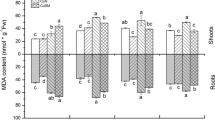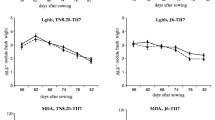Abstract
Nodulation of Medicago sativa by Sinorhizobium meliloti is challenged by acidity, but the ability of M. murex to nodulate in acid soils provided the opportunity to compare the symbiotic development between the two species in an acid sandy soil. Soil acidity had different effects on the nodulation of Medicago spp. In soil of pH 4.3, M. murex produced fewer nodules than plants grown in soil of pH 7.0, but these nodules developed at a similar rate to those on plants grown in soil of neutral pH. The uppermost nodule on M. murex formed lower down the tap-root of plants grown in soil of pH 4.3. In identical soils, M. sativa produced fewer nodules when grown in the acidic soil and nodules appeared later compared to those on plants grown in soil of pH 7.0. However, the location of the uppermost nodule was the same in plants grown in soils of pH 4.3 and 7.0. It is suggested that M. murex formed the first nodules near the actively growing root tip, while M. sativa formed nodules later at the more mature region of the root, above the root tip.
Similar content being viewed by others
References
Ballen K G, Graham P H, Jones R K and Bowers J H 1998 Acidity and calcium interaction affecting cell envelope stability in Rhizobium. Can. J. Microbiol. 44, 582–587.
Bettenay E and Hingston F J 1964 Development and distribution of soils in the Merredin area, Western Australia. Aust. J. Soil. Sci. 2, 173–186.
Bhuvaneswari T V, Bhagwat A A and Bauer W D 1981 Transient susceptibility of root cells in four common legumes to nodulation by rhizobia. Plant. Physiol. 68, 1144–1149.
Brockwell J 1982 Plant-infection counts of rhizobia in soils. In Nitrogen Fixation in Legumes. Ed. J M Vincent. pp 41–57. Academic Press, Sydney.
Caetano-Anolles G, Lagares A and Favelukes G 1989 Adsorption of Rhizobium meliloti to alfalfa roots: Dependence on divalent cations and pH. Plant. Soil. 117, 67–74.
Coventry D R and Evans J 1989 Symbiotic nitrogen fixation and soil acidity. In Soil Acidity and Plant Growth. Ed. A D Robson. pp 103–137. Academic Press Australia, Sydney.
Cransberg L and McFarlane D J 1994 Can perennial pastures provide the basis for a sustainable farming system in southern Australia? N.Z.J. Agric. Res. 37, 284–294.
Denarie J, Debelle F and Rosenberg C 1992 Signalling and host range variation in nodulation. Annu. Rev. Microbiol. 46, 497–531.
Dudley M E, Jacobs T W and Long S R 1987 Microscopic studies of cell divisions induced in alfalfa roots by Rhizobium meliloti. Planta 171, 289–301.
George R, McFarlane D and Nulsen B 1997 Salinity threatens the viability of agriculture and ecosystems in Western Australia. Hydrogeol. J. 5, 6–21.
Gibson A H 1980 Methods for legumes in glasshouses and controlled environment cabinets. In Methods for Evaluating Biological Nitrogen Fixation. Ed. F J Bergersen. pp 139–184. John Wiley & Sons, Chichester.
Haynes R J 1990 Active ion uptake and maintenance of cationanion balance: A critical examination of their role in regulating rhizosphere pH. Plant Soil 126, 247–264.
Hirsch A M 1992 Developmental biology of legume nodulation. New Phytol. 122, 211–237.
Howieson J G and Ewing M A 1986 Acid tolerance in Rhizobium meliloti-Medicago symbiosis. Aust. J. Agric. Res. 37, 55–64.
Howieson J G and Ewing M A 1989 Annual species of Medicago differ greatly in their ability to nodulate on acid soils. Aust. J. Agric. Res. 40, 843–850.
Howieson J G, Ewing M A and D'Antuono M F 1988 Selection for acid tolerance in Rhizobium meliloti. Plant Soil 105, 179–188.
Howieson J G, Nutt B and Evans P 2000 Estimation of host-strain compatibility for symbiotic N-fixation between Rhizobium meliloti, several annual species of Medicago and Medicago sativa. Plant Soil 219, 49–55.
Howieson J G, Robson A D and Ewing M A 1993 External phosphate and calcium concentrations, and pH, but not the products of rhizobial nodulation genes, affect the attachment of Rhizobium meliloti to roots of annual medics. Soil. Biol. Biochem. 25, 567–573.
Lindstrom K and Myllyniemi H 1987 Sensitivity of red clover rhizobia to soil acidity factors in pure culture and in symbiosis. Plant Soil 98, 353–362.
Long S R 1996 Rhizobium symbiosis: Nod factors in perspective. Plant Cell 8, 1885–1898.
Munns D N 1968 Nodulation of Medicago sativa in solution culture. I. Acid-sensitive steps. Plant Soil 28, 129–146.
Munns D N 1970 Nodulation of Medicago sativa in solution culture. V. Calcium and pH requirements during infection. Plant Soil 32, 90–102.
PMSEIC 1998. Dryland salinity and its impact on rural industries and the landscape. Canberra, Prime Minister's Science, Engineering and Innovation Council, Department of Industry, Science and Resources: 43.
Rayment G and Higginson F 1992 Australian laboratory handbook of soil and water chemical methods. Inkata Press, Melbourne, Australia.
Rice W A, Penney D C and Nyborg M 1977 Effects of soil acidity on rhizobia numbers, nodulation and nitrogen fixation by alfalfa and red clover. Can. J. Soil. Sci. 57, 197–203.
Robson A D and Loneragan J F 1970 Nodulation and growth of Medicago truncatula on acid soils. II. Colonization of acid soils by Rhizobium meliloti. Aust. J. Agric. Res. 21, 427–434.
Singleton P 1992 Introduction to bacteria for students of biology, biotechnology and medicine. John Wiley & Sons, Chichester. 221 p.
Tang C 1991 The role of iron in nodulation and symbiotic nitrogen fixation by legumes. Ph.D. thesis, The University of Western Australia, Perth, Australia.
Tang C, McLay C D A and Barton L 1997 A comparison of proton excretion of twelve pasture legumes grown in nutrient solution. Aust. J. Exp. Agric. 37, 563–570.
Van Rhijn P and Vanderleyden J 1995 The Rhizobium-plant symbiosis. Microbiol. Rev. 59, 124–142.
Ward P R, Dunin F X and Micin S F 2001 Water balance of annual and perennial pastures on a duplex soil in a Mediterranean environment. Aust. J. Agric. Res. 52, 203–209.
Wood S M and Newcomb W 1988 Nodule morphogenesis: The early infection of alfalfa (Medicago sativa) root hairs by Rhizobium meliloti. Can. J. Bot. 67, 3108–3122.
Author information
Authors and Affiliations
Rights and permissions
About this article
Cite this article
Cheng, Y., Watkin, E., O'Hara, G. et al. Medicago sativa and Medicago murex differ in the nodulation response to soil acidity. Plant and Soil 238, 31–39 (2002). https://doi.org/10.1023/A:1014273327527
Issue Date:
DOI: https://doi.org/10.1023/A:1014273327527




